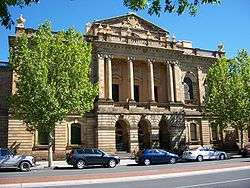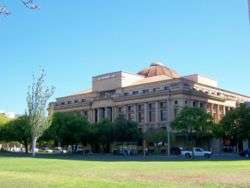Victoria Square, Adelaide




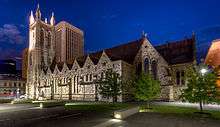
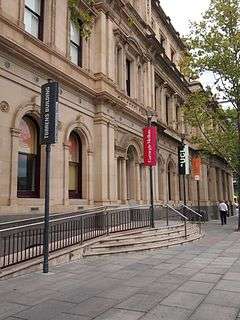
(NE corner of the Square) houses campuses of several international universities operating in South Australia
Victoria Square, also known as Tarndanyangga, is a public square in the South Australian capital of Adelaide. The square is in the centre of the city's grid of one square mile.
The area was named "Victoria Square" by the Street Naming Committee on 23 May 1837, after Princess Victoria, then heir presumptive of the British throne.[1] Less than a month later the King died and Victoria became Queen. The Kaurna people know the area as Tarndanyangga, "The Dreaming Place of the Red Kangaroo". In line with the Adelaide City Council's recognition of Kaurna country, the area is officially referred to as Victoria Square/Tarndanyangga.
A statue of Queen Victoria, from a model by C. B. Birch,[2] stands near the centre of the square. A gift to the people of Adelaide from Sir Edwin Smith, it was cast by Moore & Co. of Thames Ditton using bronze specifically made from Wallaroo and Moonta copper,[3] and unveiled by Lady Smith on 11 August 1894.
During the Christmas period, it is traditional for a 24.5m high Christmas tree to be erected in the northern part of the square.
Victoria Square is bordered by numerous public institutions at its north and south ends, including the Supreme Court of South Australia, the Adelaide Magistrates' Court, the Federal Court of Australia, the historic old Treasury building (now a hotel run by the Adina hotel chain) and the Adelaide General Post Office. On the eastern side is the Roman Catholic Cathedral Church of St Francis Xavier, the SA Water headquarters, State Government offices, including the office of the Premier, and the Torrens Building. The Torrens Building currently houses campuses of several international universities including the UCL School of Energy and Resources (a specialised graduate school of University College London), Heinz College Australia, Carnegie Mellon University, Torrens University Australia and other institutions. The west side of the square contains more commercially oriented buildings, including the Adelaide Central Market, the Hilton hotel, and the offices of various consultants, law firms and insurance companies.
King William Street passes through the square, making a diamond shape, with the southbound carriageway passing through the east side, and the northbound carriageway passing through the west side of the square. The square is bisected by the piece of road (technically part of the square) that connects Wakefield Street (entering from the east) with Grote Street (to the west). A tram stop (formerly the terminus) for the Glenelg Tramline is just south of the Queen Victoria statue; it was shifted from the centre to the western edge of the square in 2007, as part of the extension that was made to the tram line around that time.[4]
History
The link between the Aboriginal people and the Square, as a centre for the surrounding area, stretches back many centuries, to a time when Tarndanya (Red Kangaroo Dreaming) people gathered there for special ceremonies and dances. Tarndanyangga was the "headquarters" or central camp of the "Dundagunya tribe", a community numbering in the thousands.[5][6]
1837–1854
In 1837, Surveyor General Colonel William Light mapped a plan for the City of Adelaide. The design incorporated a central square to function as Adelaide's focal point and provide open space for recreational activities. On his first map, Light called the precinct 'The Great Square'. It was eventually named in honour of Princess Victoria, then heir to the throne of England.
1854–1883
The Square was a dusty, treeless paddock until 1854, when the Adelaide City Council embarked on a planting program, constructed four broad diagonal pedestrian paths and erected a wooden fence. Other work on the Square included construction of an east-west roadway that created two garden areas. A fountain was also considered, but it took a further 100 years for this idea to come to fruition.
1883–1967
By 1883, plans were under way to extend King William Street directly through Victoria Square, dividing it into four garden areas. The original wooden fence was replaced by ornate iron railings. A statue of Queen Victoria – who had ascended to the throne in June 1837 – was erected in the centre of the Square in 1894.
1967–2013
The layout remained unchanged until 1967 when the Square assumed its present diamond form. The Three Rivers Fountain by John Dowie was built to commemorate the visit of Her Majesty Queen Elizabeth II and His Royal Highness Prince Philip, Duke of Edinburgh, in 1968. The three South Australian rivers, the Murray, Onkaparinga and Torrens, are represented by an Aboriginal male with an Ibis, a female with a heron, and a female with a black swan.
During the 1960s the Aboriginal community renewed its activities in Victoria Square, with the area in front of what was then the central Police Station, (and is now the Commonwealth Law Courts building), becoming a social and gathering point.
On 12 July 1971, the red, black and yellow Aboriginal flag designed by Harold Thomas was flown for the first time – in Victoria Square.[7] It now flies permanently alongside the Australian flag on one of the two tall flagpoles in the centre of the Square. In 2002, the Adelaide City Council formally recognised this relationship by bestowing the dual name Victoria Square/Tarndanyangga.
2013–Present
In 2012 the Adelaide City Council endorsed $24 million in funding to begin rejuvenating Victoria Square. Construction commenced in March 2013 and the first of two planned stages (the northern half) was completed in February 2014. It is unlikely that the second half will go ahead as planned. The full development included:
|
|
Gallery
-

Three Rivers Fountain, 2007
-
Carnegie Mellon University (Torrens Building)
-
Three Rivers Fountain at night, 2008
-

H-class tram at the then Victoria Square Terminus, 2005
-
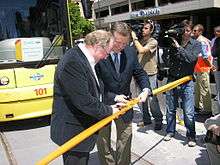
The then Premier and Minister of Transport opening the Glenelg Tramline extension, 14 October 2007
-
Tramline extension in use, 2008
-

North-western corner of the Square, 2006, looking north-east - prior to the Tramline extension and square renovations
-
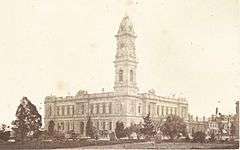
The Adelaide GPO (General Post Office), c. 1869. Construction was completed in 1867
-

Water feature, 2014
-

Christmas tree, 2014
References
- ↑ "History of Adelaide through street names - Land forms". www.historysouthaustralia.net. Retrieved 2008-04-09.
- ↑ The statue was from an improved model Birch created for an Indian prince variously cited as the Maharajah of Oodeypore, Dodeypore, and Bulrampore (yet to be identified), unveiled by Prince Albert Victor in 1889.
- ↑ "The Queen's Statue". South Australian Chronicle. XXXVI, (1,853). South Australia. 24 February 1894. p. 7. Retrieved 17 May 2016 – via National Library of Australia.
- ↑ "Tramline Extension". www.infrastructure.sa.gov.au. Archived from the original on 31 August 2007. Retrieved 2008-04-09.
- ↑ Adelaide Botanic Gardens Conservation Study - 5.0 Assessment of Cultural Significance DEWNR, 2006. Accessed 13 September 2014.
- ↑ Adelaide Park Lands & Squares Cultural Landscape Assessment Study > 3.1.33 Tarndanyangga/Victoria Square Report David Jones, Corporation of the City of Adelaide, 2007. Accessed 13 September 2014.
- ↑ "Indigenous Australian flags". NAIDOC. Archived from the original on 6 July 2011. Retrieved 11 July 2011.
Coordinates: 34°55′50″S 138°36′15″E / 34.93056°S 138.60417°E

